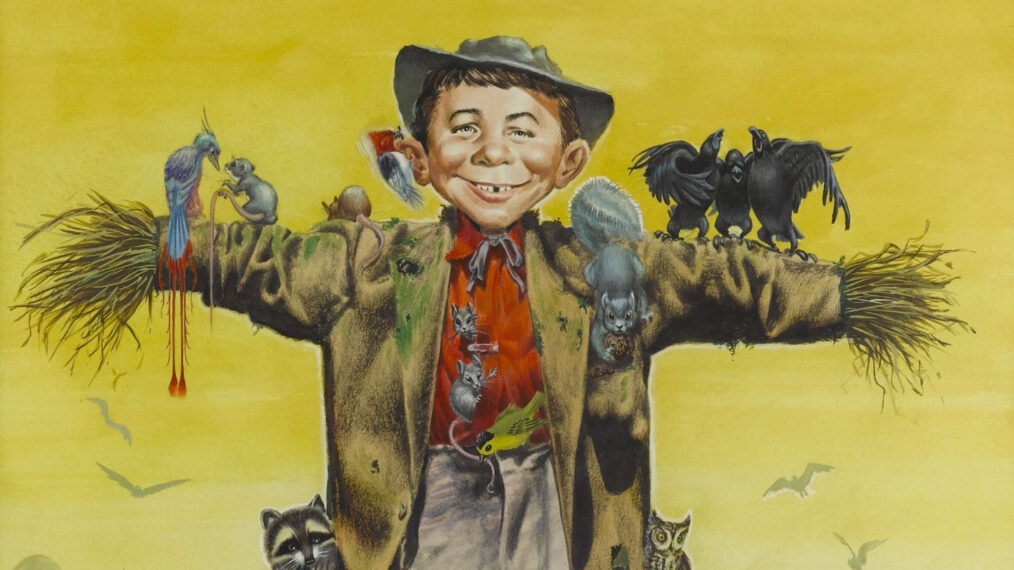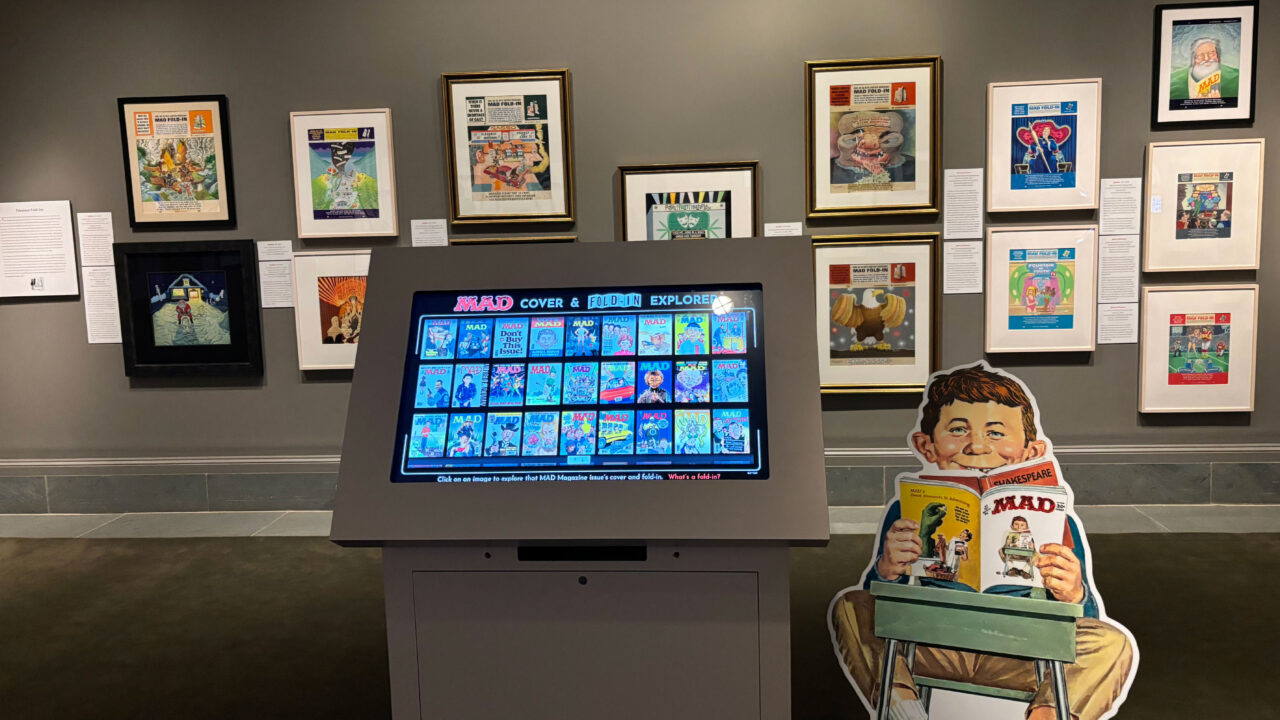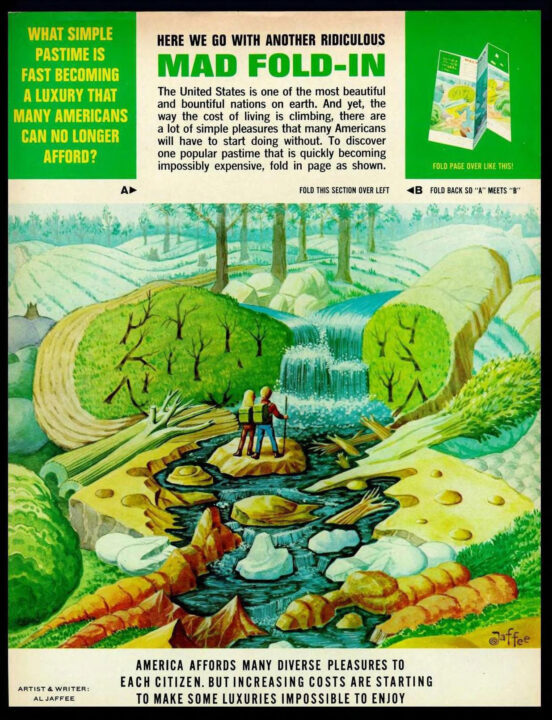The World’s Dumbest Cover Boy Is on Full Display

The world’s dumbest cover boy — the red-headed, freckle-faced Alfred E. Neuman is turning heads once again. Neuman, the fictitious mascot of MAD magazine, is part of a current exhibition on display through October that highlights the art of MAD magazine. In a thoughtful and highly amusing segment on CBS News Sunday Morning Sunday, Sept. 22, correspondent David Pogue visited the Norman Rockwell Museum in Stockbridge, Massachusetts.
The exhibit is co-curated by political cartoonist Steve Brodner. “I was formed by MAD magazine,” Brodner says. “My idea of irreverent humor, irreverent drawing comes from this.”
Started in 1952, MAD began as a sendup of comic books that were popular in that era, but through the counterculture-era of the ’60s and beyond, would develop into one of the greatest pillars of American satire, lampooning everything from pop-culture trends, movies, television, politics, stereotypes and conventions of the day.

Sam Viviano
Alfred E. Neuman for President, 2008
Cover illustration for MAD No. 495, November 2008
© & ™ E.C. Publications. Courtesy of DC. All Rights Reserved. Used with permission.
Pogue interviews several individuals who helped create MAD’s voice over the years, including John Ficarra, who served as editor of the magazine for 33 years. Pogue speaks to his own memories of MAD, and how he didn’t always get the jokes that were on offer. Ficarra admits that he and the “Usual Gang of Idiots” — the name that the creators of the magazine used to refer to themselves — never worried about. “That was sort of the charm. We figured, either kids will get it, or they won’t and they’ll look it up, or five years later, they’re looking at old MADs and saying, ‘Oh, now I get that joke.’”
The exhibit on display at the Norman Rockwell Museum features memorable work from MAD stalwarts like Al Jaffee, whose work appeared in all but one issue of the magazine, and who died last year at the age of 102. In a file interview, Jaffee quipped about the work he and his fellow “Idiots” did at MAD: “People have been doing satire for ages. The only difference is, most of them ended up in dungeons, and we wind up on the newsstand.”

Courtesy of Norman Rockwell Museum
It was Jaffee who was responsible for creating one of the most popular institutions in all of MAD magazine history, the MAD fold-in on the back cover, in which a pressing cultural question is addressed in a full-page illustration with text, with a snotty answer revealed by folding part of the page over itself.

Al Jaffee (1921-2023)
What Simple Pastime is Becoming a Luxury that Many Americans Can No Longer Afford? 1979
Fold-In illustration for MAD #172, (EC, 1979)
© & ™ E.C. Publications. Courtesy of DC. All Rights Reserved. Used with permission.
A whole room of the exhibit at the Norman Rockwell Museum is given over to the work of the late Mort Drucker, the master caricaturist responsible for illustrating loads of classic movie and TV parodies. Brodner shows Pogue a panel Drucker’s drawings from his parody of 1972’s The Godfather as a perfect example of his effectiveness as a satirist, along with drawings skewering the likes of All in the Family, Seinfeld and Cosby.

Courtesy of Norman Rockwell Museum
According to Drucker’s daughter, Laurie Drucker Bachner, her father had almost no training whatsoever as an artist or illustrator. “He did go to Parsons for three months, and they told him he really was not cut out to be an artist,” she says. Drucker took that advice with a grain of salt and went on to draw for MAD for more than 50 years.
“He really loved people,” Drucker Bachner remembers. “And I think that’s why he was such a successful caricaturist, because he inhaled the persona of somebody, and wanted them to be realized in the best way possible.”

Mort Drucker (1929-2020)
The Oddfather (Parody of The Godfather, The Godfather Turns 40), 1972
Illustration for MAD #155 (EC, 1972)
© & ™ E.C. Publications. Courtesy of DC. All Rights Reserved.
The good times lasted quite a long time — the Usual Gang of Idiots stayed with MAD for decades, giving it a consistent flair and voice for most of its life. In another file interview, we hear from original publisher Bill Gaines about the success of MAD in spite of its no-advertising policy — a conscious decision so as to never be beholden to any entity that it might care to spoof or lampoon in its pages. After Gaines’ death in 1992, the magazine passed through a series of often-ridiculous owners, as outlined by Ficarra and writer Dick DeBartolo, whose work appeared in every issue of MAD for 55 years. After being sold to Warner Publishing in a deal struck by Gaines, Warner sold the property to AT&T, who, according to Ficarra, “really screwed it up — please don’t cut that out!” And according to DeBartolo, “for a very brief time, it was Smucker’s jams and jellies — we thought, ‘How did we get there??’” The company was sold again to Discovery Networks.
It was an often-absurd ride, but MAD ultimately would heavily influence satire in the U.S., from Saturday Night Live to The Simpsons, whose creator, Matt Groening, has always acknowledged his debt to the magazine. Other cultural icons whose legacies involve satire, from “Weird” Al Yankovic to Stephen Colbert and John Stewart all cop to having been under its spell in their formative years.
“MAD created a revolution in the United States,” Brodner pointedly tells Pogue, speaking directly to the magazine’s enduring legacy of encouraging critical thinking. “People are still saying, ‘I don’t believe that. I’m going to investigate this and see what the truth of it is. And I think that’s what MAD is saying — don’t believe the con.”
The Norman Rockwell Museum is open six days a week (closed on Wednesdays) from 10am-5pmET. The MAD Magazine exhibit is included with general admission and will be on display at the museum until Oct. 27, 2024.
